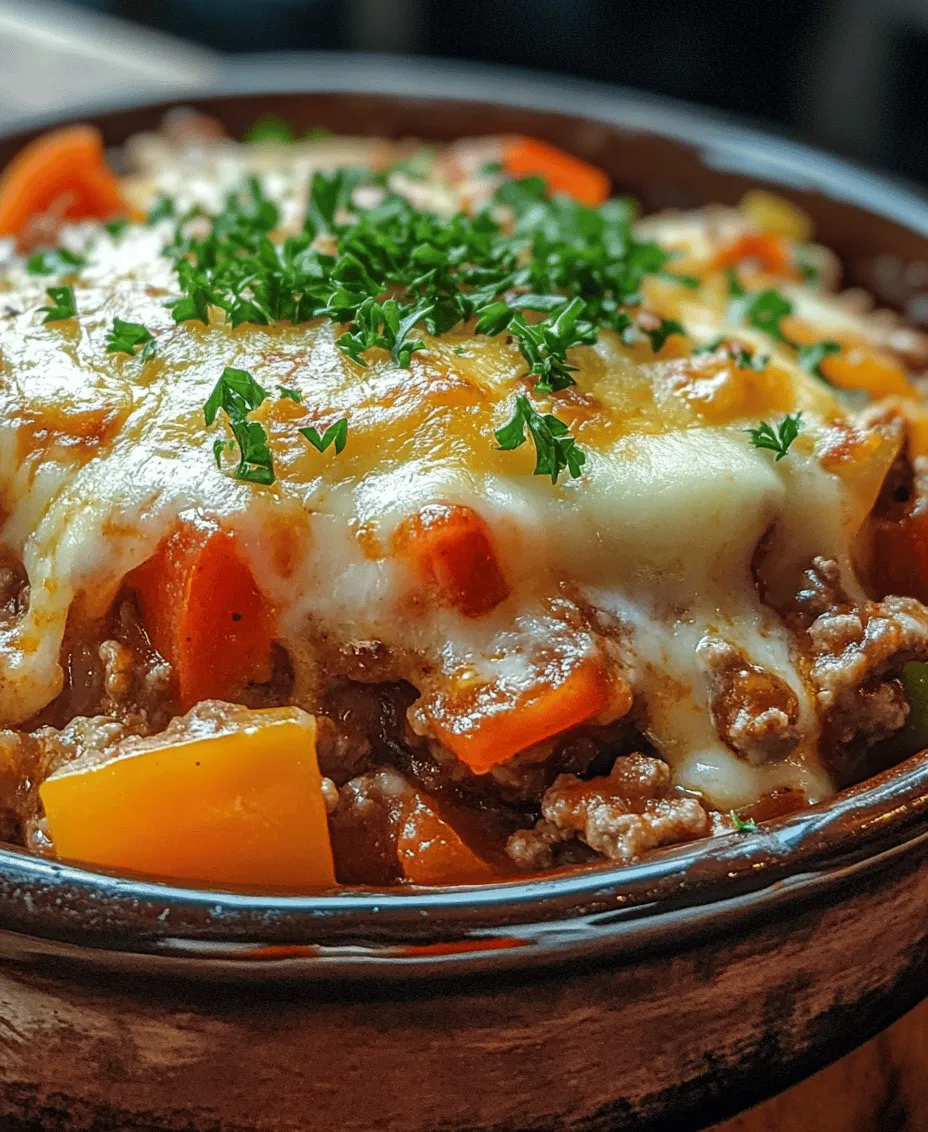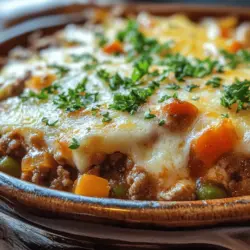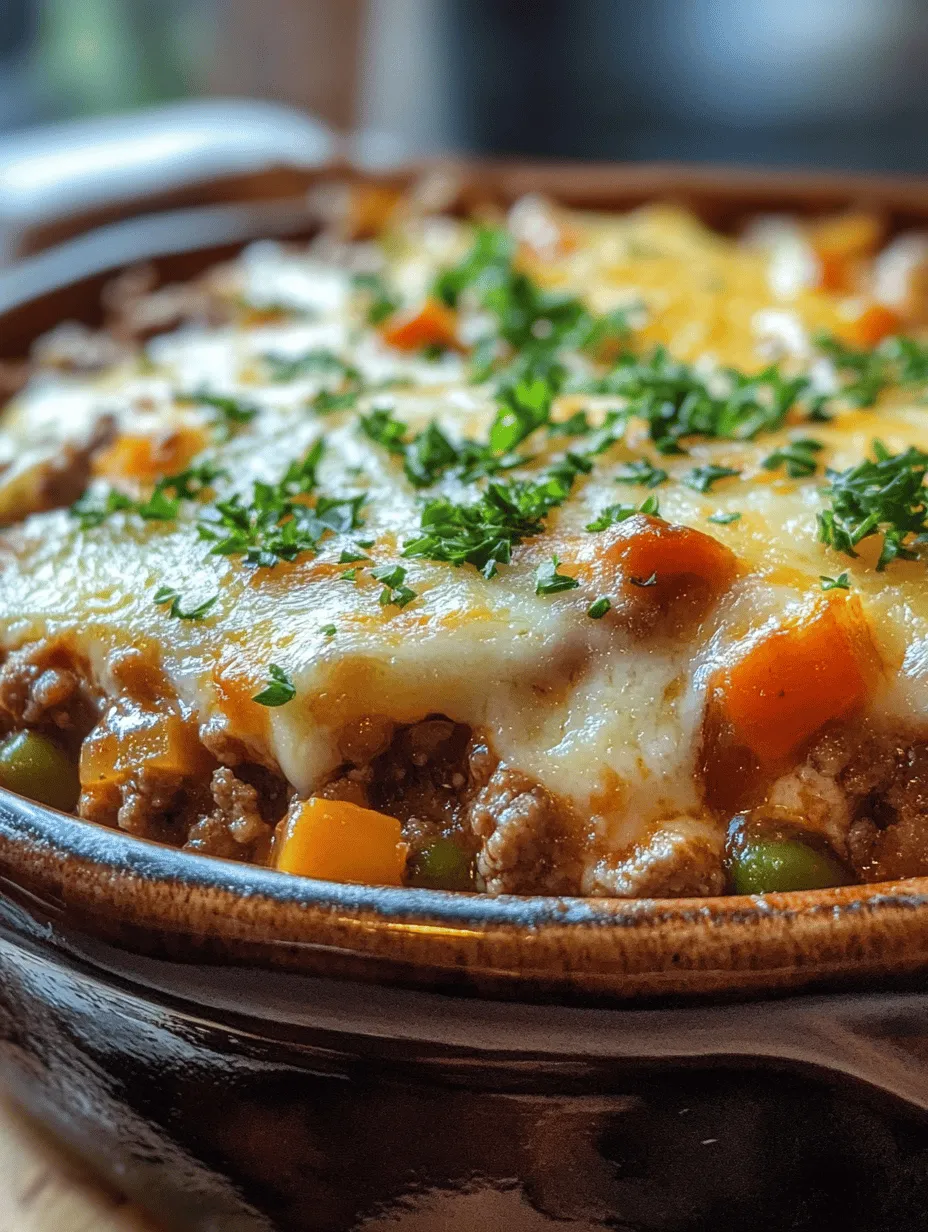Introduction to Poor Man’s Husband Casserole
Casserole dishes have long been a staple in kitchens around the world, celebrated for their practicality and comforting nature. Among these beloved recipes, Poor Man’s Husband Casserole stands out as a perfect embodiment of affordability and heartiness, making it a go-to choice for families and budget-conscious cooks alike. This dish offers a delightful combination of ground meat, rice, and mixed vegetables, all enveloped in a rich, savory sauce that brings warmth to any dining table.
The name “Poor Man’s Husband Casserole” has an intriguing backstory. It is said to have originated during the Great Depression, a time when families needed to stretch their food budgets while still providing filling meals. The dish is a testament to resourcefulness, utilizing inexpensive ingredients to create a satisfying meal that can feed a crowd. As the name suggests, it is a simple yet hearty dish that many believe could “keep a husband happy” while remaining budget-friendly. This cultural significance adds a layer of nostalgia for many who grew up enjoying this casserole on chilly evenings, making it not just a meal but a cherished memory.
One of the key features of Poor Man’s Husband Casserole is its affordability without compromising on flavor or nutrition. The dish typically includes ground meat, which is not only economical but also a great source of protein. Coupled with rice and an assortment of vegetables, it provides a well-rounded meal that can be enjoyed by the whole family. Whether you’re hosting a gathering, looking for a weeknight dinner solution, or simply trying to please picky eaters, this casserole can easily adapt to your needs, making it an invaluable addition to your recipe collection.
Understanding the Core Ingredients
Ground Meat Selection
When it comes to selecting ground meat for your Poor Man’s Husband Casserole, both beef and turkey are popular choices, each with its own set of benefits. Ground beef is rich in flavor and creates a robust base for the casserole. Its higher fat content contributes to a juicier dish, making it a favorite among those who appreciate a savory punch. However, if you’re looking for a healthier option, ground turkey is an excellent alternative. It is leaner and lower in calories, making it ideal for those aiming to reduce fat intake while still enjoying a hearty meal. Additionally, turkey absorbs the flavors from the spices and vegetables beautifully, ensuring that every bite is delicious.
The Role of Vegetables
Vegetables play a crucial role in the Poor Man’s Husband Casserole, both for their nutritional value and their contribution to texture. A medley of mixed vegetables, such as peas, carrots, and corn, not only adds vibrant color to the dish but also enhances its overall flavor profile. Vegetables are packed with essential vitamins and minerals, making the casserole a more balanced meal. The variety in textures—from the crunch of carrots to the softness of peas—creates a delightful eating experience, ensuring that each forkful is both satisfying and nourishing.
Rice: White vs. Brown Rice
Another essential ingredient in this casserole is rice, which acts as a filling agent, binding all the flavors together. When choosing between white and brown rice, both options have their merits. White rice is quick-cooking and has a softer texture, making it a convenient choice for busy weeknights. On the other hand, brown rice is a whole grain, offering more fiber and nutrients, which can contribute to a healthier meal. However, it takes longer to cook and may require additional liquid in the casserole. Depending on your dietary preferences and time constraints, you can choose the rice that best fits your needs.
Seasoning: The Influence of Italian Seasoning
Seasoning is where the magic happens in Poor Man’s Husband Casserole. Italian seasoning, a blend of herbs such as oregano, basil, and thyme, elevates the dish’s flavor, infusing it with aromatic notes that complement the meat and vegetables beautifully. This seasoning not only adds depth but also contributes to the dish’s comforting quality. The balance of herbs creates a well-rounded flavor profile that makes every bite feel like a warm embrace. Feel free to adjust the quantity to suit your taste; a little extra can go a long way in enhancing the overall experience.
Preparation Essentials for a Successful Casserole
Prepping the Ingredients
Preparation is key to a successful Poor Man’s Husband Casserole. Ensuring that all your ingredients are prepped before you begin cooking will streamline the process and lead to a more enjoyable cooking experience. Start by dicing your vegetables and mincing your garlic and onion. This not only promotes even cooking but also allows the flavors to meld together more seamlessly. Having everything ready to go means you can focus on the cooking process without feeling rushed or overwhelmed.
Cooking Techniques
Understanding the cooking techniques involved is crucial for achieving the perfect casserole. Sautéing the ground meat and vegetables before assembling the dish is essential. This step enhances the flavors by allowing the meat to brown and the vegetables to soften, creating a savory base for your casserole. Simmering the mixture afterward allows the flavors to develop further and the rice to absorb the liquid, making every bite rich and satisfying. Each technique plays a significant role in the overall outcome, so take your time and enjoy the process.
Choosing the Right Casserole Dish
The choice of casserole dish can affect both cooking time and the final presentation of your Poor Man’s Husband Casserole. Opt for a dish that suits your oven size and desired serving quantity. Glass, ceramic, and metal dishes all have their pros and cons; glass retains heat well but can be heavier, while metal dishes heat up quickly but may not distribute heat as evenly. Ensure your casserole dish is deep enough to accommodate all the ingredients without overflowing, allowing for proper cooking and layering.
Step-by-Step Guide to Making Poor Man’s Husband Casserole
Preheating the Oven
Before diving into the cooking process, preheat your oven to the specified temperature. This step is crucial for ensuring that the casserole cooks evenly. A properly preheated oven helps the dish to develop a golden-brown top while keeping the insides moist and flavorful. Aim for a temperature around 350°F (175°C) for optimal results, allowing the casserole to bake through without burning.
Cooking the Meat
Start by heating a tablespoon of oil in a large skillet over medium heat. Add your ground meat of choice—whether beef or turkey—and cook until it is browned and fully cooked. This step usually takes about 5-7 minutes, depending on the meat’s fat content and the heat level. Use a spatula to break up the meat into small pieces, ensuring even cooking. Season the meat with salt, pepper, and a sprinkle of Italian seasoning to infuse flavor early on. Once the meat is cooked, transfer it to a bowl and set it aside for later.
Combining Ingredients
Next, it’s time to combine the ingredients. In the same skillet, add your prepped vegetables—such as diced onions, carrots, and peas—and sauté them for about 3-4 minutes until they begin to soften. This step is critical for enhancing the flavors and achieving a balanced texture in your casserole. After the vegetables are tender, return the ground meat to the skillet and mix everything together. Add the rice, any remaining seasoning, and enough broth or water to cook the rice according to package instructions. Stir well to ensure even distribution of flavors throughout the mixture.
Transferring to the Casserole Dish
Once everything is well combined, it’s time to transfer the mixture to your chosen casserole dish. Use a spatula to scoop the mixture into the dish, creating an even layer across the bottom. This layering technique is vital for ensuring that all ingredients cook uniformly. Spread the mixture evenly, pressing it down slightly to eliminate air pockets. For added flavor, sprinkle a little extra cheese on top before placing it in the oven.
By following these steps, you’re well on your way to creating a delicious Poor Man’s Husband Casserole that embodies comfort, affordability, and the warmth of home-cooked meals. Stay tuned for the next part, where we will delve deeper into the baking process and additional tips for serving this hearty dish!

Adding Cheese: Choosing the Right Type and How It Enhances the Dish
Cheese is one of the most delightful additions to any casserole, and Poor Man’s Husband Casserole is no exception. When choosing the right cheese, consider flavor, meltability, and texture. Cheddar cheese is a popular choice due to its sharp flavor and excellent melting properties. It adds a rich, creamy texture that beautifully complements the ground meat and mixed vegetables.
If you prefer a milder cheese, mozzarella can be an excellent alternative. Its stretchy, gooey consistency when melted makes for a delightful experience. For a more gourmet touch, you might consider Gruyère or Monterey Jack; both bring unique flavors and a creamy texture that enhance the overall dish.
To integrate cheese into your casserole, sprinkle a generous layer over the top during the last 15-20 minutes of baking. This allows the cheese to melt and form a beautiful golden crust, elevating the dish’s visual appeal and flavor profile. Don’t shy away from experimenting with different types of cheese; mixing varieties like gouda and parmesan can create a complex flavor that your family will adore.
Baking Process: Importance of Covering vs. Uncovering During Cooking
The baking process is crucial for achieving the perfect texture and flavor in Poor Man’s Husband Casserole. Initially, cover the casserole with aluminum foil for the first half of the baking time. This helps to trap steam within the dish, which keeps the casserole moist and prevents it from drying out. Additionally, the covered environment allows the flavors to meld beautifully.
After the first 30-40 minutes, remove the foil to allow the top to crisp up and develop a delicious golden-brown finish. This uncovered phase is essential for achieving that satisfying texture contrast between the moist filling and the crispy top layer. Be sure to keep an eye on the casserole during this time to prevent over-browning.
Final Touches: The Significance of Letting the Casserole Rest Before Serving
After pulling your casserole from the oven, resist the temptation to serve it immediately. Letting it rest for about 10-15 minutes is essential for several reasons. First, this resting period allows the casserole to set, making it easier to cut into neat squares or wedges. If you serve it too quickly, it may fall apart, leading to a less appetizing presentation.
Moreover, resting allows the flavors to continue developing and melding together. The heat will redistribute, resulting in a more enjoyable eating experience. During this time, you can prepare your serving dishes and side accompaniments, ensuring a well-rounded meal.
Nutritional Benefits of Poor Man’s Husband Casserole
Balanced Meal: Analysis of Proteins, Carbohydrates, and Fats
Poor Man’s Husband Casserole is not just a comforting dish; it’s also a well-balanced meal. The ground meat provides ample protein necessary for muscle growth and maintenance, while the starch component, typically from potatoes or pasta, delivers carbohydrates that give energy. The inclusion of cheese adds healthy fats, which are essential for nutrient absorption and overall health.
Vitamins and Minerals: Contribution from Mixed Vegetables and Herbs
The mixed vegetables in your casserole play a crucial role in its nutritional profile. Ingredients like carrots, peas, and bell peppers contribute various vitamins and minerals, such as Vitamin A, Vitamin C, potassium, and dietary fiber. These nutrients support immune function, skin health, and digestion. Additionally, fresh herbs like parsley or thyme can enhance flavor while providing antioxidants and promoting overall well-being.
Portion Control: Serving Sizes and Their Impact on Dietary Goals
When it comes to portion control, Poor Man’s Husband Casserole can be easily adapted to fit various dietary goals. A standard serving size is typically around one-quarter of the casserole, which provides a satisfying meal without excessive caloric intake. For those watching their weight or looking to maintain a healthy diet, consider serving the casserole alongside a fresh green salad or steamed vegetables to increase volume while keeping calories in check.
Variations and Customizations
Vegetarian Adaptations: Substituting Meat with Plant-Based Proteins
If you want to make Poor Man’s Husband Casserole vegetarian-friendly, consider swapping out the ground meat for plant-based proteins. Options such as lentils, chickpeas, or textured vegetable protein (TVP) can provide the protein content and texture necessary to create a satisfying meal. Additionally, using mushrooms can enhance the umami flavor, making the dish hearty and delicious.
Spice It Up: Adding Heat with Peppers or Spices
For those who enjoy a kick of heat, consider adding diced jalapeños, red pepper flakes, or hot sauce to the casserole. These spices can elevate the flavor profile significantly and add exciting depth to the dish. Adjust the spiciness according to your preference, ensuring it complements rather than overwhelms the other flavors.
Cheese Alternatives: Exploring Different Cheese Options for Flavor
In addition to the traditional cheese options, you can explore various alternatives to cater to different dietary requirements or flavor preferences. For example, vegan cheese is a great substitute for those avoiding dairy. Nutritional yeast can also be sprinkled on top before baking for a cheesy flavor without the fat content.
Serving Suggestions and Pairings
Ideal Side Dishes: Complementary Foods to Enhance the Meal Experience
When serving Poor Man’s Husband Casserole, consider pairing it with light and refreshing side dishes. A simple green salad with a balsamic vinaigrette can balance the richness of the casserole. Alternatively, steamed green beans or roasted broccoli provides a colorful and nutrient-dense accompaniment, enhancing the overall meal experience.
Presentation Tips: How to Serve for Visual Appeal
Presentation plays a vital role in the enjoyment of any meal. To serve your casserole appealingly, consider using a deep dish with a contrasting color to the casserole itself, allowing the colors of the ingredients to pop. Garnish with fresh herbs like parsley or chives for a splash of color and freshness. Serving individual portions in bowls can also create a cozy, inviting atmosphere.
Storage and Reheating: Best Practices for Leftovers
If you have leftovers, storing them properly is key to maintaining flavor and texture. Allow the casserole to cool completely before transferring it to an airtight container. It can be stored in the refrigerator for up to three days or frozen for up to three months. When reheating, cover the dish with foil to retain moisture and prevent it from drying out. Heat in the oven at 350°F (175°C) until warmed through, or microwave individual portions for quick meals.
Conclusion: Embracing the Comfort of Poor Man’s Husband Casserole
Poor Man’s Husband Casserole is more than just a meal; it’s a heartfelt dish that embodies comfort and nourishment. Its versatility allows for creativity in the kitchen, making it a canvas for personal expression and preferences. Whether you choose to stick to the classic recipe or explore variations that cater to your dietary needs, this casserole is sure to become a staple in your home.
As you embark on your culinary journey with Poor Man’s Husband Casserole, remember the joy of cooking and sharing meals with loved ones. Each bite can evoke memories and create new traditions, making this dish a comforting reminder of home. So gather your ingredients, invite your family to the kitchen, and embrace the warmth and comfort this casserole brings to your table.


